History of Oil Industry
The oil industry started over 500 years ago and oil seeping up through the ground was mostly applied in waterproofing ships, medicine, lighting, and as paints for decoration and maintenance (Pratt, 2012).
During this period, the demand for oil products was greatly higher than the supply, and several oil companies and individuals were searching for an alternative and durable source, currently called black gold. Aside from a short period of coal oil, the solution was accompanied with the expansion of drilling for crude oil, and land wells were foremost. As the demand for oil products went on to advance, exploration companies started to search for other sources like sea bed.
Gulf of Mexico was the initial region where the oil well equipment was constructed, which was located in open waters. These structures were located in water depths of around 90 meters and built in a form of a piled jacket arrangement, where a framed template contained piles that were fixed in it to attach these structures to the sea bed. Such structures found in the sea bed were the precursors for the huge platforms currently found in the extremely deep waters and in several places all over the globe.
Land oil wells have been present since the 1910s in Europe. Only in the 1970s the discovery in the North Sea actually started, however, for the further several years no any successful achievements could be seen. Eventually, in late 1960s, oil had been stuck (Pratt, 2012). There have been explorations of new oil fields since that time and succeeding expansion of the North Sea is among the supreme investment plans in the globe.
History of ExxonMobil Company
ExxonMobil is an American Multinational oil and gas company that is originated from Standard Oil Company and established by John D. Rockefeller (Pratt, 2012). It was launched in 1999 when there was joined venture by Exxon and Mobil. The company has its main offices in Irving, Texas. Exxon Mobil Corporation (NYSE: XOM) is associated with a Canadian’s Imperial Oil, which is among the leading companies in Canada (Pratt, 2012).
ExxonMobil is among the biggest publicly traded organizations based on market capitalization in the globe and is the biggest organization in the globe based on the income. It is also positioned number three in the world by Forbes Global listing in 2012.
Reserves contained by ExxonMobil were around 70 billion barrels during the evaluation in 2008. During that time, the production rates were anticipated to be steady for around 14 years.
ExxonMobil contains 37 oil refineries in around 20 countries in the world that make up a joined daily refining volume of about 6.2 million barrels (Pratt, 2012). This makes this company to be the biggest refiner in the globe. This is a rank that was merged with Standard Oil found in Canada since its integration in 1870s.
ExxonMobil is the biggest of the six oil giants with weekly output of 27.447 million BOE. It produces almost three percent of the global inputs (Pratt, 2012). This is also less than the output of some of the biggest oil companies that are managed by government.
Current Status
About seven billion people in the globe receive around 60% of oil and gas in their daily normal energy requirement and the remaining part of 40% is received from hydroelectric generation, nuclear, and coal. Other basic sources include solar power, and biomass elements. Currently, oil stands for international commerce on an extensive scale and international markets are fast developing. Various oil companies allocate billions of dollars yearly to sustain and expand their oil and gas output.
More than 200 countries have requested oil and gas companies to bargain for the rights to use their lands or territorial waters since they are expecting that these companies will discover and generate oil and gas to the country, produce local employment, and finally support the country’s economy by inserting billions of money.
In the middle of 2008, ExxonMobil revealed an intention to change its process from direct-served retail market to another advanced process due to the increasing complexity of managing gas stations that were experiencing the increasing prices of crude oil.
This huge process of transition slowly threw ExxonMobil out of the direct-served retail market, and finally had an influence on 800 company-owned stations and around 1,500 other gas stations managed by entrepreneurs supplying oil across the countries. ExxonMobil introduced XTO energy into the world market in 2010 and focused on growth and creation of alternative resources to reduce risk and adapt the competitive market setting.
Macroeconomic Indicators
Economic Indicators
Economic indicators in every company are valuable since they help in understanding the underlying factors of the market. Particular economic indicators that companies watch will regularly rely on the market where the companies are functioning (Spangenberg, 2011). For oil companies, the key emphasis will be on economic indicators that give information concerning the oil industry.
The best indicators applied by most energy companies are the crude inventories, or sometimes called stock levels, which show the quantity of oil presently kept for the future use. The figures and other changes provide energy companies with a concept of the trends in use and production of oil in a particular period of time.
Unemployment Rates
ExxonMobil needs also to focus on the present employment situations. The company may analyze the Employment Index indicator that evaluates the degree of employment among the people involved in the industry or establishment-based employment. Most people believe that these companies can specifically discover from the daily establishment studies since they disclose the industrial sectors that contain a huge demand for jobs and sectors that do not require extra workforce.
These companies can particularly focus on the outcome at the entries on “manufacturing/ service provision and retail trade” (Spangenberg, 2011). Here, they can evaluate the results with statistics from the sources that are portraying employment levels in the oil sectors.
From such figures, these companies can execute new approaches in recruiting new workers and keep older workers in a view of transforming conditions in the oil industry. ExxonMobil can analyze trends in recruiting new employees from different racial groups with the intention of maintaining shared opportunity conditions in employment as they impose advance standards in the quality of production generated by these workers.
Consumer Price Index (CPI)
Consumer Price Index (CPI) is usually an important measure for oil companies, or ExxonMobil, since the Consumer Price Index changes in prices of essential consumer commodities (Hunter, 2012).
ExxonMobil, example of other oil companies, is the top producer of products associated with petroleum products that are among the commodities, which are being evaluated by the Consumer Price Index. Most people believe that it is essential for the company to follow the monthly changes in consumer prices through the Consumer Price Index, which allows the company to plan the pricing system that it contains in trading its commodities.
Certainly, this will rely on the demand and supply level for commodities associated with petroleum. It is essential for the company to understand the variation in prices based on the present economic conditions that the country undergoes along with the current market situations in the petroleum sector.
Macroeconomic Indicators and the Company Data Indicators
Economic Indicators
Figure 1: Oil Price and GDP Growth (Hunter, 2012).
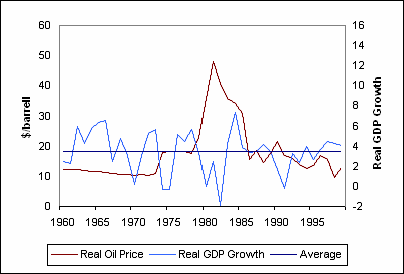
Figure 2: ExxonMobil Growth Rate.
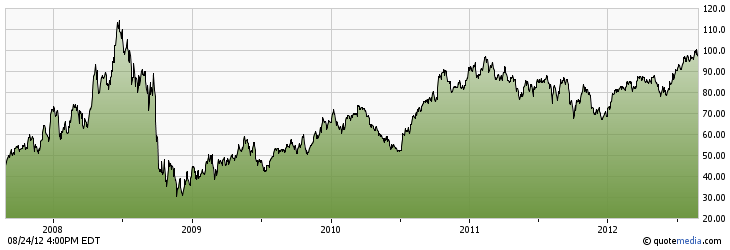
Employment Rate Indicator
Figure 3: National Employment Rate (Hunter, 2012).
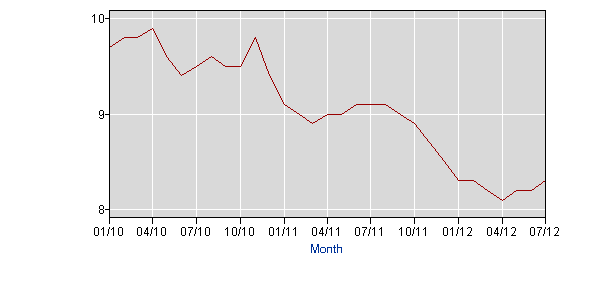
Figure 4: ExxonMobil Employment Rate.
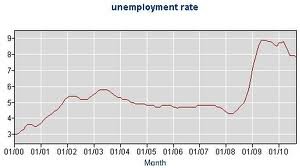
Consumer Price Index (CPI)
Chart 1: CPI and the CPI excluding energy (Hunter, 2012).
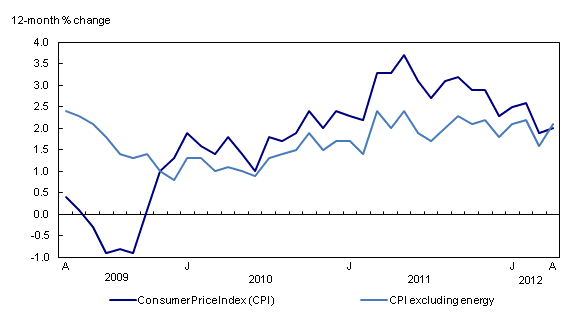
Data Analysis
The graphs above concerning GDP and ExxonMobil growth show more directly the manner in which the oil prices actually impact the unemployment rate. The graphs also illustrate decreasing GDP and negative economic effects on sensitive oil prices, which can affect the economy of the country. Graphs (ExxonMobil and microeconomic indicators) show that there is a fluctuation in the rates. The highest points were recorded in 2008 and in the middle of 2012.
ExxonMobil employment rate nearly went constant from January 2003 to January 2008, when it started raising sharply due to the increase of employment. While employment rate shown in the microeconomic indicator provides that the rates have been undergoing upset in their figures since they have been declining since 2010. This shows that ExxonMobil may experience a distinct growth in employment and expansion in the branch outlet across the world.
The graph above shows that the figures for national and ExxonMobil differ in the point that the Consumer Price Index (CPI) for microeconomic indicators is slightly below the figures of the company. The rate dropped in 2009 and both steadily rose in the middle of 2009, but dropped again in the start of 2011. This made the beginning of 2011 to be the highest Consumer Price Index (CPI) point since 2009.
Future Opportunities and Challenges
ExxonMobil has a collection of major opportunities with a current research focusing on varieties of exploration, technology growth, and project feasibility analysis, which are in line with the oil and gas industry in the world. Success in the future of oil and gas industry should call for the on-going revision of a strategic business approaches to figure out challenges and difficulties governing this industry (Sen, 2012).
It is also expected that participation of oil companies in the country will improve economic and employment status. The future of oil industry will also increase in looking at success and production since more fields are free for exploration and advanced technology of the oil markets in the world.
The major challenge is to make sure that both new and exposed resources can be generated in an environmentally and economically position to attain raising demand and counterbalance natural field drop. Environmental worries have already resulted to limitations to explore in regions potential for the oil industry in the world.
Discovering economic approaches to resolve this challenge is a part of the problem that serves as a field of higher competition inside oil and gas industry. Environmental factors and financial activities may be among the challenges that developing countries will experience in the future.
References
Hunter, P. (2012). Main Economic Indicators. MEI Methodological Analysis, 2: 7-59.
Pratt, J. (2012). Exxon and the Control of Oil. Journal of American History, 99(1): 145-154.
Sen, A. (2012). Mortality as an Indicator of Economic Success and Failure. The Economic Journal, 108: 1-25.
Spangenberg, J. (2011). Economic sustainability of the economy: concepts and indicators. Int. J. Sustainable Development, 8(2): 47-64.